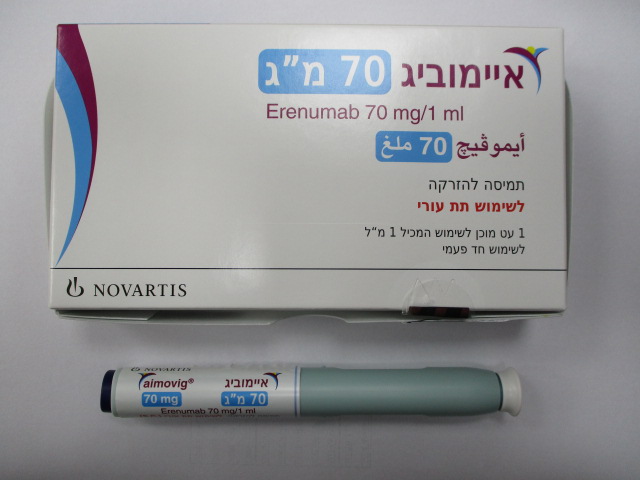Quest for the right Drug

איימוביג 70 מ"ג AIMOVIG 70 MG (ERENUMAB)
תרופה במרשם
תרופה בסל
נרקוטיקה
ציטוטוקסיקה
צורת מתן:
תת-עורי : S.C
צורת מינון:
תמיסה להזרקה : SOLUTION FOR INJECTION
עלון לרופא
מינוניםPosology התוויות
Indications תופעות לוואי
Adverse reactions התוויות נגד
Contraindications אינטראקציות
Interactions מינון יתר
Overdose הריון/הנקה
Pregnancy & Lactation אוכלוסיות מיוחדות
Special populations תכונות פרמקולוגיות
Pharmacological properties מידע רוקחי
Pharmaceutical particulars אזהרת שימוש
Special Warning עלון לרופא
Physicians Leaflet
Adverse reactions : תופעות לוואי
4.8 Undesirable effects Summary of the safety profile A total of over 2,500 patients (more than 2,600 patient years) have been treated with Aimovig in registration studies. Of these, more than 1,300 patients were exposed for at least 12 months and 218 patients were exposed for 5 years. The overall safety profile of Aimovig remained consistent for 5 years of long-term open-label treatment. The reported adverse drug reactions for 70 mg and 140 mg were injection site reactions (5.6%/4.5%), constipation (1.3%/3.2%), muscle spasms (0.1%/2.0%) and pruritus (0.7%/1.8%). Most of the reactions were mild or moderate in severity. Less than 2% of patients in these studies discontinued due to adverse reactions. Tabulated list of adverse reactions Table 1 lists all adverse drug reactions that occurred in Aimovig-treated patients during the 12-week placebo-controlled periods of the studies, as well as in the post-marketing setting. Within each system organ class, the ADRs are ranked by frequency, with the most frequent reactions first. Within each frequency grouping, adverse drug reactions are presented in order of decreasing seriousness. In addition, the corresponding frequency category for each adverse drug reaction is based on the following convention: very common (≥1/10); common (≥1/100 to <1/10); uncommon (≥1/1,000 to <1/100); rare (≥1/10,000 to <1/1,000); very rare (<1/10,000); not known (cannot be estimated from the available data). Table 1 List of adverse reactions System Organ Class Adverse reaction Frequency category Immune system disorders Hypersensitivity Common reactionsa including anaphylaxis, angioedema, rash, swelling/oedema and urticaria Gastrointestinal disorders Constipation Common b Oral sores Not known Skin and subcutaneous tissue disorders Pruritusc Common Alopecia Not known Rashd Musculoskeletal and connective tissue Muscle spasms Common disorders General disorders and administration site Injection site reactionsa Common conditions a See section “Description of selected adverse reactions” b Oral sores includes preferred terms of stomatitis, mouth ulceration, oral mucosal blistering. c Pruritus includes preferred terms of generalised pruritus, pruritus and pruritic rash. d Rash includes preferred terms of rash papular, exfoliative rash, rash erythematous, urticaria, blister. AIM API Aug23 V8 Page 4 of 14 EU SmPC July23 Description of selected adverse reactions Injection site reactions In the integrated 12-week placebo-controlled phase of the studies, injection site reactions were mild and mostly transient. There was one case of discontinuation in a patient receiving the 70 mg dose due to injection site rash. The most frequent injection site reactions were localised pain, erythema and pruritus. Injection site pain typically subsided within 1 hour after administration. Cutaneous and hypersensitivity reactions In the integrated 12-week placebo-controlled phase of the studies, non-serious cases of rash, pruritus and swelling/oedema were observed, which in the majority of cases were mild and did not lead to treatment discontinuation. In the post-marketing setting, cases of anaphylaxis and angiodoema were observed. Immunogenicity During the double-blind treatment phase of the clinical studies, the incidence of anti-erenumab antibody development during the double-blind treatment phase was 6.3% (56/884) among subjects receiving a 70 mg dose of erenumab (3 of whom had in vitro neutralising activity) and 2.6% (13/504) among subjects receiving the 140 mg dose of erenumab (none of whom had in vitro neutralising activity). In an open-label study with up to 256 weeks of treatment, the incidence of anti-erenumab antibody development was 11.0% (25/225) among patients who only received 70 mg or 140 mg of Aimovig throughout the entire study (2 of whom had in vitro neutralising activity). There was no impact of anti-erenumab antibody development on the efficacy or safety of erenumab . Reporting of suspected adverse reactions Reporting suspected adverse reactions after authorisation of the medicinal product is important. It allows continued monitoring of the benefit/risk balance of the medicinal product. Any suspected adverse events should be reported to the Ministry of Health according to the National Regulation by using an online form: https://sideeffects.health.gov.il

שימוש לפי פנקס קופ''ח כללית 1994
לא צוין
תאריך הכללה מקורי בסל
לא צוין
הגבלות
לא צוין
מידע נוסף
עלון מידע לצרכן
11.08.22 - עלון לצרכן אנגלית 12.10.21 - עלון לצרכן עברית 11.08.22 - עלון לצרכן עברית 11.08.22 - עלון לצרכן עברית 11.08.22 - עלון לצרכן עברית 11.08.22 - עלון לצרכן ערבית 14.07.20 - החמרה לעלון 19.11.20 - החמרה לעלון 12.10.21 - החמרה לעלון 09.01.22 - החמרה לעלון 11.08.22 - החמרה לעלון 21.04.20 - החמרה לעלון 08.05.23 - החמרה לעלון 03.08.23 - החמרה לעלוןלתרופה במאגר משרד הבריאות
איימוביג 70 מ"ג